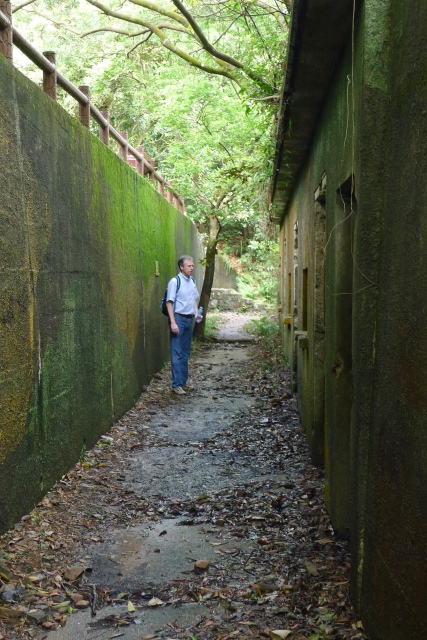December 7th 1941
The Japanese Imperial Navy has just attacked the American Naval Base, Pearl Harbour in the Pacific and the American nation is shaken, but not entirely stirred. The United States of America is declaring war on the Japanese and it is clear to everyone that the World War has now reached the Pacific massively. A long desire from Winston Churchill for US to join the war and support the allies defence of the Axe Powers, has finally come through. Already the following day Japanese aircrafts attacked the Royal Air Force contingent based at Kai Tak airfield, situated on the mainland of the British Crown Colony of Hong Kong. This attack destroyed all of the dated aircraft available and was clearly a prelude to a land invasion of Hong Kong , from the Chinese mainland, that would result in the capture of the Colony and the entire garrison within only eighteen days.
April 2012

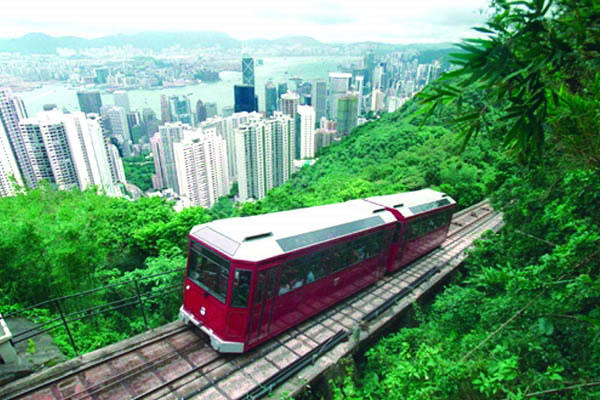 My family and I have just stepped out of "The Peak Tram," which is a sort of train or tram, that via a very steep rail is pulled up of the hillside of VictoriaPeak by cables, from the center of Hong Kong to "The Victoria Peak". It has been one of the major attractions for locals for many years and still is. On the way up the hillside, you get a very nice view over the city and the wooded hillsides.
My family and I have just stepped out of "The Peak Tram," which is a sort of train or tram, that via a very steep rail is pulled up of the hillside of VictoriaPeak by cables, from the center of Hong Kong to "The Victoria Peak". It has been one of the major attractions for locals for many years and still is. On the way up the hillside, you get a very nice view over the city and the wooded hillsides.
We have now reached the top of the mountain, 300 meters up, and have arrived in the beautiful sunshine. It quickly becomes clear to us why this attraction through the ages has been and still is, an experience you MUST see. From this key point, we will be able to walk for about 45 minutes, via the small narrow roads, blasted into the hillside out to "The Pinewood  Battery" which is rather untouched after the associated army units had to pull away after having been displaced by the Japanese. Since the Japanese did not want to give the battery a role under their 3-year occupation of Hong Kong, the remains were simply allowed to stand and fall away. The battery was never rebuilt or put in recycling after the Japanese surrender in 1945, as it was clear to everyone that it had no any effective strategic importance anymore.
Battery" which is rather untouched after the associated army units had to pull away after having been displaced by the Japanese. Since the Japanese did not want to give the battery a role under their 3-year occupation of Hong Kong, the remains were simply allowed to stand and fall away. The battery was never rebuilt or put in recycling after the Japanese surrender in 1945, as it was clear to everyone that it had no any effective strategic importance anymore.
We are now heading down the narrow mountain road and enjoy the cool and humid air. There is a lot of noise from the many birds, so it is clear that even the birds are enjoying this sunny day. We pass a cooling waterfall and many beautiful vantage points along the way to the battery. Up and down, in and out and often down and up narrow stairs, where it is clearly beneficial to be in good shape ... which obviously is not the case for me. I can not believe that this could have been the primary access route to the battery. A smaller vehicle would barely be able to get through to the battery, however a larger truck with grenades and supplies would be too broad for this road. This would undoubtedly 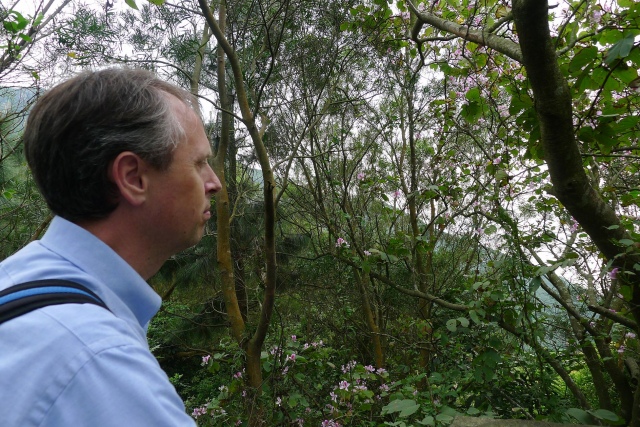 be considered a patrol road that would allow the troops to keep an eye at the harbour front deep below. After a little research on the smart phone, it appears that the main access is located on the other side of the mountain in cover of the vegetation. It will later appear at the return trip along this particular road, it was not much wider, but could though handle a
be considered a patrol road that would allow the troops to keep an eye at the harbour front deep below. After a little research on the smart phone, it appears that the main access is located on the other side of the mountain in cover of the vegetation. It will later appear at the return trip along this particular road, it was not much wider, but could though handle a  larger truck with supplies. After a long and sweaty walk, driven solely by the desire to experience new exciting things, we arrive finally at the defense battery. It turns out to be a fairly comprehensive defense complex and the battery case, where anti-aircraft positions had originally stood in the bloody weeks of 1941, it appears that shattered ruins appear just as it was abandoned in 1941. Nothing has been renovated, so apart from the vegetation that has grown up, you get a good sense of where fierce the fighting has been.
larger truck with supplies. After a long and sweaty walk, driven solely by the desire to experience new exciting things, we arrive finally at the defense battery. It turns out to be a fairly comprehensive defense complex and the battery case, where anti-aircraft positions had originally stood in the bloody weeks of 1941, it appears that shattered ruins appear just as it was abandoned in 1941. Nothing has been renovated, so apart from the vegetation that has grown up, you get a good sense of where fierce the fighting has been.
December 1941 - the Bloody Battle of Hong Kong
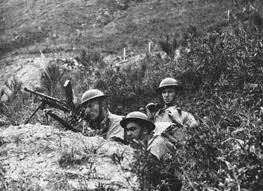 Around 8:00 AM on December 8, Japanese forces under Lieutenant General Takashi Sakai began their anticipated attack on Hong Kong. The Imperial Japanese Army crossed the Shum Chun River, the British Colony's land border with China, They quickly advanced through the New Territories and captured the main allied defensive position called the "Gin Drinker's Line". This was a line of pill boxes and artillery observation posts - sadly undermanned by the defending forces. The quick breakthrough surprised Lieutenant General Takashi Sakai as he had anticipating needing a month to penetrate the British defenses. Falling back, the British Major General, Christopher Maltby, began evacuating his troops from Kowloon to Hong KongIsland on December 11. Destroying harbor and military facilities as they departed, the final Commonwealth troops left the mainland on December 13. On the same day, after the bitter fighting, Sakai demanded that the British should surrender. This was promptly refused and two days later the Japanese began shelling the island's northern shore. Another surrender demand was rejected on December 17. The next day, Sakai began landing troops on the island's northeastern coast near Tai Koo. Pushing back the defenders, the Japanese units were later guilty of killing prisoners of war Sai Wan Battery and Salesian Mission, which sadly would be just another incident of many respectless incidents during the entire war campaign, which sadly would be the tradesmark of the Japenese offenders during WW2. Driving west and south, the Japanese met heavy resistance over the next two days. On December 20 they succeeded in reaching the south coast of the island effectively splitting the defenders in two. While part of Maltby's command continued the fight on the western part of the island, the remainder was hemmed in on the StanleyPeninsula. By the evening of 12 December, the attackers were in possession of the whole of the mainland, including the Kowloon peninsula north of Hong Kong island
Around 8:00 AM on December 8, Japanese forces under Lieutenant General Takashi Sakai began their anticipated attack on Hong Kong. The Imperial Japanese Army crossed the Shum Chun River, the British Colony's land border with China, They quickly advanced through the New Territories and captured the main allied defensive position called the "Gin Drinker's Line". This was a line of pill boxes and artillery observation posts - sadly undermanned by the defending forces. The quick breakthrough surprised Lieutenant General Takashi Sakai as he had anticipating needing a month to penetrate the British defenses. Falling back, the British Major General, Christopher Maltby, began evacuating his troops from Kowloon to Hong KongIsland on December 11. Destroying harbor and military facilities as they departed, the final Commonwealth troops left the mainland on December 13. On the same day, after the bitter fighting, Sakai demanded that the British should surrender. This was promptly refused and two days later the Japanese began shelling the island's northern shore. Another surrender demand was rejected on December 17. The next day, Sakai began landing troops on the island's northeastern coast near Tai Koo. Pushing back the defenders, the Japanese units were later guilty of killing prisoners of war Sai Wan Battery and Salesian Mission, which sadly would be just another incident of many respectless incidents during the entire war campaign, which sadly would be the tradesmark of the Japenese offenders during WW2. Driving west and south, the Japanese met heavy resistance over the next two days. On December 20 they succeeded in reaching the south coast of the island effectively splitting the defenders in two. While part of Maltby's command continued the fight on the western part of the island, the remainder was hemmed in on the StanleyPeninsula. By the evening of 12 December, the attackers were in possession of the whole of the mainland, including the Kowloon peninsula north of Hong Kong island
After the Battle - the violent Occupation of Hong Kong
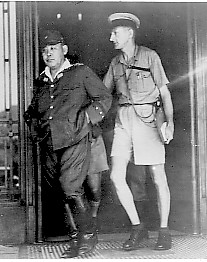 The surrender to the Japanese followed by the occupation of Hong Kong began after the
The surrender to the Japanese followed by the occupation of Hong Kong began after the  Governor of Hong Kong, Sir Mark Young, surrendered the territory of Hong Kong to JapanDecember 25th, 1941, also remembered as "The Black Christmas". After 18 days of fierce fighting by British, Indian and Canadian defenders against an overwhelming Japanese Imperial army they had to see themselves beaten. The occupation lasted for three years and eight months until Japan surrendered in 1945. The surrender of Hong Kong cost the British around 9,500 captured as well as 2,113 killed/missing and 2,300 wounded during the battle. Japanese casualties in the fighting numbered 1,996 killed and around 6,000 wounded. Just before the British surrendered, drunken Japanese soldiers entered St. Stephen's College, which was being used as a hospital. The Japanese then confronted two volunteer doctors and shot both of them when entry was refused followed by the same troops bursting into the wards and bayoneted all the wounded soldiers who were incapable of hiding in what was known as the St. Stephen's college incident. The occupation lasted for three years and eight months until Japan surrendered in 1945. This incident was the cruel taste of what was to be expected from a completely twisted Japanese Army where respect for other human beings was non existing. The terrorization did not only involve army personnel, but in very high numbers also civilians. This explains the severe and strong resistance and hard fighting by the voluntary Chinese forces under British command. It was for many of the troops all about defending their homes, families and own existence.In that respect, sadly Hong Kong became another "Black Pearl" on the string of Japanese terror in Asia Pacific during WW2.
Governor of Hong Kong, Sir Mark Young, surrendered the territory of Hong Kong to JapanDecember 25th, 1941, also remembered as "The Black Christmas". After 18 days of fierce fighting by British, Indian and Canadian defenders against an overwhelming Japanese Imperial army they had to see themselves beaten. The occupation lasted for three years and eight months until Japan surrendered in 1945. The surrender of Hong Kong cost the British around 9,500 captured as well as 2,113 killed/missing and 2,300 wounded during the battle. Japanese casualties in the fighting numbered 1,996 killed and around 6,000 wounded. Just before the British surrendered, drunken Japanese soldiers entered St. Stephen's College, which was being used as a hospital. The Japanese then confronted two volunteer doctors and shot both of them when entry was refused followed by the same troops bursting into the wards and bayoneted all the wounded soldiers who were incapable of hiding in what was known as the St. Stephen's college incident. The occupation lasted for three years and eight months until Japan surrendered in 1945. This incident was the cruel taste of what was to be expected from a completely twisted Japanese Army where respect for other human beings was non existing. The terrorization did not only involve army personnel, but in very high numbers also civilians. This explains the severe and strong resistance and hard fighting by the voluntary Chinese forces under British command. It was for many of the troops all about defending their homes, families and own existence.In that respect, sadly Hong Kong became another "Black Pearl" on the string of Japanese terror in Asia Pacific during WW2.
April 2012
 I am now walking around the bombed complex and trying to get an overview. You hear the merchant ships in the distance mixed with the many voices of birds. A cool breeze blows in from the sea. Even though plants and trees have grown up in the area it is easy to perceive how the defending troops must have felt pressured during the intense Japanese gunfire and bombardment. Completely devoid of both incoming fire from the air and water-side. Many shell holes bear witness to a very precise shooting and why the position quickly had to be left. We are walking around in silence. Not many visitors have found their way out here, surely not least due to the strenuous hike. I am glad that we persevered and now find ourselves on the spot, which was the goal of our hike. Many of manning and storage reservoirs are still in quite good condition. All steel installations, including the heavy steel doors to the many stores are gone, but it can clearly be seen that the local authorities' attention to this part of the story is more accommodating and come in to support various projects that can expose the relatively large number of military installations in the area, by allow access via marked and maintained footpaths. What makes Hong Kong unique in this respect is not only the large number of installations that are scattered around the area for the city's small size, but also the fact that Hong Kong despite a rapid growth and urban development have been able to maintain these many areas untouched. For comparison, one can in Singapore note that the part of the local history is "hidden away" in favor of constant urban development and expansion of the infrastructure with the loss of an important part of the region's variegated culture. This includes not only the key military areas from a violent war story, but also other important cultural items, such as historical Chinese cemeteries, which are still being kept by the Chinese population. These must often be sacrificed in favor of residential buildings and highways and there are constant discussions in the press from a more active population of the danger
I am now walking around the bombed complex and trying to get an overview. You hear the merchant ships in the distance mixed with the many voices of birds. A cool breeze blows in from the sea. Even though plants and trees have grown up in the area it is easy to perceive how the defending troops must have felt pressured during the intense Japanese gunfire and bombardment. Completely devoid of both incoming fire from the air and water-side. Many shell holes bear witness to a very precise shooting and why the position quickly had to be left. We are walking around in silence. Not many visitors have found their way out here, surely not least due to the strenuous hike. I am glad that we persevered and now find ourselves on the spot, which was the goal of our hike. Many of manning and storage reservoirs are still in quite good condition. All steel installations, including the heavy steel doors to the many stores are gone, but it can clearly be seen that the local authorities' attention to this part of the story is more accommodating and come in to support various projects that can expose the relatively large number of military installations in the area, by allow access via marked and maintained footpaths. What makes Hong Kong unique in this respect is not only the large number of installations that are scattered around the area for the city's small size, but also the fact that Hong Kong despite a rapid growth and urban development have been able to maintain these many areas untouched. For comparison, one can in Singapore note that the part of the local history is "hidden away" in favor of constant urban development and expansion of the infrastructure with the loss of an important part of the region's variegated culture. This includes not only the key military areas from a violent war story, but also other important cultural items, such as historical Chinese cemeteries, which are still being kept by the Chinese population. These must often be sacrificed in favor of residential buildings and highways and there are constant discussions in the press from a more active population of the danger 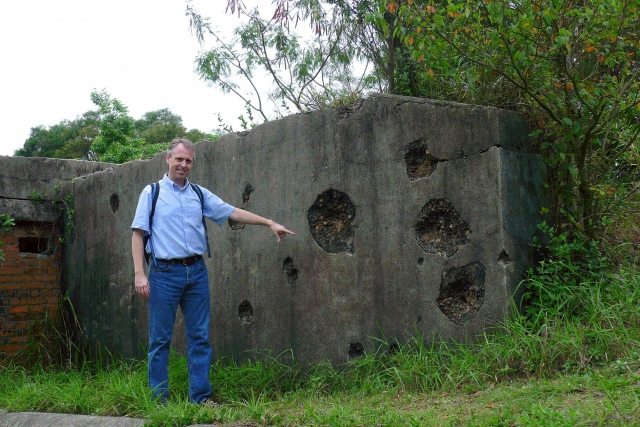 of losing its history. We have simply reached a point where people are losing their culture and the youth have no knowledge of their own parents 'or grandparents' story. It is clearly felt by us, being permanent visitors. In Hong Kong it is clearly different, which of course also can be attributed to the British authorities' influence over the decades, that has allowed that Hong Kong's role as a progressive and modern trade area has kept a constant and appreciated link to the area's important history, which admittedly is not always nice, but is necessary to understand in order to understand the future. Within the past few years, a cooperation between local enthusiasts, museum people and authorities have uncovered an increasing number of WW2 sites and there are now a plethora of "WW2 Heritage Trails" each with its own history.
of losing its history. We have simply reached a point where people are losing their culture and the youth have no knowledge of their own parents 'or grandparents' story. It is clearly felt by us, being permanent visitors. In Hong Kong it is clearly different, which of course also can be attributed to the British authorities' influence over the decades, that has allowed that Hong Kong's role as a progressive and modern trade area has kept a constant and appreciated link to the area's important history, which admittedly is not always nice, but is necessary to understand in order to understand the future. Within the past few years, a cooperation between local enthusiasts, museum people and authorities have uncovered an increasing number of WW2 sites and there are now a plethora of "WW2 Heritage Trails" each with its own history.
An interesting little anecdote on these areas, which also illustrates how it was all chaotic and in fact was left untouched after the bloody fighting in 1941, was that all the way up to 1947, the medias start publishing articles in the local newspapers about the untouched battle sites; “Whether it was about time to start cleaning up the many theaters of war and have the increasing number of human remains from the defending soldiers, that were most likely just adding to the extensive list of “Missing in Action” personnel, that were uncovered by rain and other elements over the years. Just as in Singapore and other places that played key roles in WW2, the continued skeletal remains of both civilians and military personnels, are exposed every year as a grim reminder of the history. I can not help but think that a lot of families in India, Canada, Australia, New Zealand and England , never had any certainty about where their loved ones ended their days. Everlasting uncertainty and at best, only a telegram with the words, "Missed in Action” as a memory of a family member. Sad!
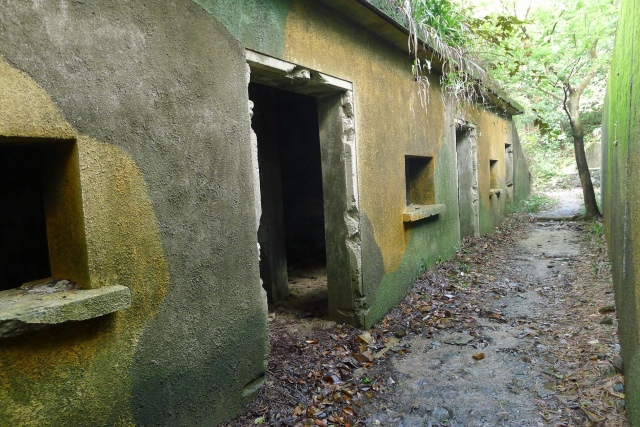
After a long and event filled day followed by a good dinner at the historic restaurant, "The Peak 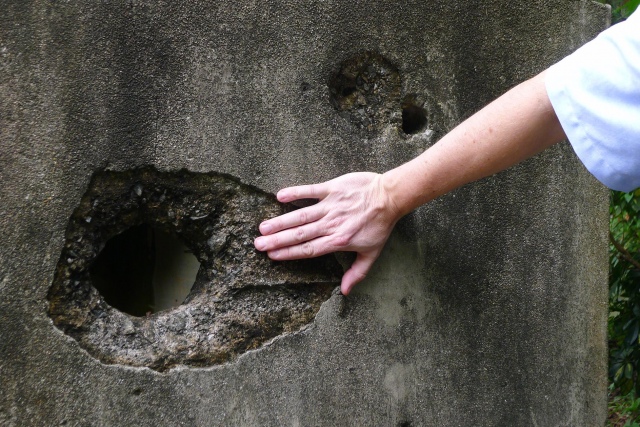 Lookout", which also witnessed the bloody years of Hong Kong, where we could digest the day's experiences, we are now in “The Tramp” on the way back down the mountain. We do not talk much and thoughts are flying around in my head. Once again I am grateful to not have experienced these bleak years personally and have the privilege only to study it from a historical standpoint. We must pay our respect to all the young men and women who made their ultimate effort against injustice and their struggle for freedom and against an aggressive and cynical nation with no respect for human life.
Lookout", which also witnessed the bloody years of Hong Kong, where we could digest the day's experiences, we are now in “The Tramp” on the way back down the mountain. We do not talk much and thoughts are flying around in my head. Once again I am grateful to not have experienced these bleak years personally and have the privilege only to study it from a historical standpoint. We must pay our respect to all the young men and women who made their ultimate effort against injustice and their struggle for freedom and against an aggressive and cynical nation with no respect for human life.
